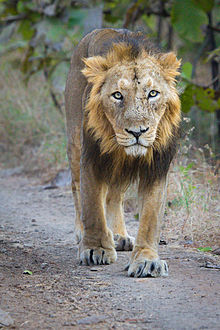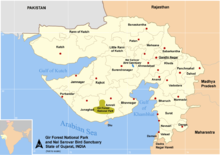亚洲狮
亚洲狮(学名:Panthera leo leo)或称印度狮,狮子的一个亚种,又名“波斯亚种”,是亚洲仅次于老虎之后第二的大猫科动物[2],原广泛分布在从地中海西岸到印度北部的广大地区,大部分野生种群已经灭绝,仅在印度古吉拉特邦的吉尔保护区内有少量分布。
| 亚洲狮 | |
|---|---|

| |
| 雄性亚洲狮 | |

| |
| 雌性亚洲狮 | |
| 科学分类 | |
| 界: | 动物界 Animalia |
| 门: | 脊索动物门 Chordata |
| 纲: | 哺乳纲 Mammalia |
| 目: | 食肉目 Carnivora |
| 科: | 猫科 Felidae |
| 属: | 豹属 Panthera |
| 种: | 狮 P. leo
|
| 亚种: | 亚洲狮 P. l. leo
|
| 三名法 | |
| Panthera leo leo | |

| |
| 亚洲狮现今的野外分布地 | |
| 异名 | |
亚洲狮现今在野外的族群只生活在印度西部古吉拉特邦的吉尔森林国家公园,根据2015年5月发布的调查,族群数量约有523只[3][4]。历史上它们的分布地囊括了从高加索至也门及由希腊的马其顿经伊朗、阿富汗及巴基斯坦至印度及孟加拉边境的大片区域。
值得注意的是,原分布在亚洲的狮子亚种还有印度亚种(学名:Panthera leo goojratensis),主要分布在印度南部,已灭绝。2017年,国际自然保护联盟猫科动物专家小组(Cat Specialist Group, CSG)的猫科分类小组(Cat Classification Taskforce)基于基因研究成果亚洲狮和巴巴里狮形态学和分子遗传学上的相似性,将亚洲狮归入Panthera leo leo。[5][6]但有些科学家继续使用旧学名,Panthera leo persica。[7][8][9][10][11][12]
特征及行为
编辑亚洲狮的毛皮较其非洲近亲蓬松,尾巴端的穗及肘上的毛发较长。雄狮及雌狮的腹部都有明显折叠的皮肤。亚洲狮是所有狮子亚种中最细小的,雄狮重160-190公斤,雌狮重110-120公斤。[13][14]科学纪录上最长的雄狮长292厘米,肩高最高达107厘米。[15]最大被猎杀的雄狮则长3米。[16]
亚洲狮是高度群居的动物。亚洲狮群较非洲狮群细小,平均只有两只雌狮。雄性亚洲狮较少群居,只会在交配或猎食大型动物时,才会与狮群联系。有指狮群的大小可能是与猎物的体型有关,亚洲狮所处理的猎物较非洲的细小,而狮子的数量亦不用太多。[17]亚洲狮的猎物主要是水鹿、花鹿、蓝牛羚、印度瞪羚、野猪及家畜。它们还能捕食沼泽鳄。
保育状况
编辑印度的吉尔森林国家公园约有411只亚洲狮,生活在1412平方公里的丛林及辽阔的落叶林。于1907年获得全面保护时,它们估计就只有13只存活。到了1936年,第一次替吉尔森林国家公园内的亚洲狮进行统计,它们就有234只存活。
孟加拉虎曾与亚洲狮一起生活在印度,印度人却更崇拜亚洲狮,由于过度猎杀和开发环境,而现在亚洲狮却退居西南一隅。亚洲猎豹喜欢栖息在辽阔的草原,而亚洲狮则喜欢栖息在茂密的森林。由于人类人口的暴涨,使得它们的栖息地不断减少,且成为当地及英国殖民者的猎杀对象。
近亲繁殖
编辑野外的亚洲狮群估计约有411只,相信是源自13只存活的亚洲狮,故很有可能是高度的近亲繁殖。很多研究都指近亲繁殖会出现较弱的免疫系统及不育的精子。早期的研究指亚洲狮的遗传指纹分析就像是一对双胞胎[18],使它们很易染病及有70-80%的精子瓦解,若再进行近亲繁殖,则会导致不育。后来的研究指亚洲狮低的遗传变异性可能是它们原有的特质,而非源自近亲繁殖。原因是它们的免疫分型与虎的很接近,且精子没有异样。[19][20]不过这项研究是使用不适合群族遗传研究的随机扩增多态性DNA技术,故其结果受到质疑。[21]
1900年代的13只亚洲狮的数量有指是不准确的,目的是要夸大问题来遏止猎杀。一些当时的统计指亚洲狮的数量应该接近100只。[22]猎杀狮子是当时英国殖民者及印度皇室的欢迎的活动,在印度的其他狮子亚种都因此而灭绝。
威胁
编辑亚洲狮由于会袭击家畜,故经常被毒杀。农民为了灌溉而挖掘的水井,也会令亚洲狮失足而溺毙。位于吉尔森林国家公园周边的农民经常使用非法电网,避免蓝牛羚来吃农作物,但也会杀死亚洲狮。[23]
在吉尔森林国家公园附近的玛尔德哈里牧民虽然是素食者,并不会猎杀亚洲狮作为食物。不过他们平均每家饲有50只牛,令当地过份放牧。这种破坏令亚洲狮的猎物失去栖息地,它们于是转向攻击牛群或人类。这些牧民现已迁离吉尔森林国家公园。
历史
编辑亚洲狮曾分布在欧洲。阿里士多德及希罗多德都指巴尔干半岛有狮子出没。于前480年,波斯王泽克西斯一世曾进驻马其顿,有几只骆驼被狮子杀死。约于80年至100年,狮子已从希腊的边境消失。这些欧洲的狮子有可能是亚洲狮的一群,或是另一个亚种的欧洲狮,或是穴狮的馀种。
于1968年,在北非发现了巴巴里狮的头颅骨。这些骨颅骨与好望角狮子、亚洲狮及非洲狮子的头颅骨有相同的特征。故此,估计北非及亚洲的狮子有著很亲密的关系,而已灭绝的欧洲狮可能就是这条失落的关连。一些巴巴里狮可能是与北非的亚洲狮交配后,混种产下较大或较细小的狮子。
参考
编辑- ^ Breitenmoser, U., Mallon, D.P., Ahmad Khan, J. & Driscoll, C. Panthera leo persica. The IUCN Red List of Threatened Species 2008. [2009-03-17].
- ^ 存档副本. [2014-06-26]. (原始内容存档于2020-11-24).
- ^ DeshGujarat. Asiatic Lion population up from 411 to 523 in five years. 2015 [2015-05-10]. (原始内容存档于2020-12-16).
- ^ Anonymous. Asiatic lion population in Gujarat rises to 523. Deccan Herald. 2015 [2016-01-09]. (原始内容存档于2019-05-15).
- ^ Kitchener, A. C.; Breitenmoser-Würsten, C.; Eizirik, E.; Gentry, A.; Werdelin, L.; Wilting, A.; Yamaguchi, N.; Abramov, A. V.; Christiansen, P.; Driscoll, C.; Duckworth, J. W.; Johnson, W.; Luo, S.-J.; Meijaard, E.; O’Donoghue, P.; Sanderson, J.; Seymour, K.; Bruford, M.; Groves, C.; Hoffmann, M.; Nowell, K.; Timmons, Z. & Tobe, S. A revised taxonomy of the Felidae: The final report of the Cat Classification Task Force of the IUCN Cat Specialist Group (PDF). Cat News. 2017,. Special Issue 11: 71–73 [2019-08-18]. (原始内容存档 (PDF)于2020-01-17).
- ^ Yamaguchi, N.; Kitchener, A. C.; Driscoll, C. A.; Macdonald, D. W. Divided infraorbital foramen in the lion (Panthera leo): its implications for colonisation history, population bottlenecks, and conservation of the Asian lion (P. l. persica). Contributions to Zoology. 2009, 78 (2): 77–83 [2019-08-16]. doi:10.1163/18759866-07802004. (原始内容存档于2020-06-02).
- ^ Singh, H. S. Dispersion of the Asiatic lion Panthera leo persica and its survival in human-dominated landscape outside the Gir forest, Gujarat, India. Current Science. 2017, 112 (5): 933–940. doi:10.18520/cs/v112/i05/933-940 .
- ^ Singh, A. P. & Nala, R. R. Estimation of the Status of Asiatic Lion (Panthera leo persica) Population in Gir Lion Landscape, Gujarat, India. Indian Forester. 2018, 144 (10): 887–892.
- ^ Schnitzler, A. & Hermann, L. Chronological distribution of the tiger Panthera tigris and the Asiatic lion Panthera leo persica in their common range in Asia. Mammal Review. 2019, 49 (4): 340–353. S2CID 202040786. doi:10.1111/mam.12166.
- ^ Finch, K.; Williams, L. & Holmes, L. Using longitudinal data to evaluate the behavioural impact of a switch to carcass feeding on an Asiatic lion (Panthera leo persica). Journal of Zoo and Aquarium Research. 2020, 8 (4): 283–287. doi:10.19227/jzar.v8i4.475.
- ^ Chaudhary, R.; Zehra, N.; Musavi, A. & Khan, J.A. Spatio-temporal partitioning and coexistence between leopard (Panthera pardus fusca) and Asiatic lion (Panthera leo persica) in Gir protected area, Gujarat, India. PLOS ONE. 2020, 15 (3): e0229045. Bibcode:2020PLoSO..1529045C. PMC 7065753 . PMID 32160193. doi:10.1371/journal.pone.0229045 .
- ^ Sood, P. Biogeographical distribution of Asiatic Lion (Panthera leo persica), Cheetah (Acinonyx jubatus venaticus) in ancient, medieval and modern Rajasthan: Study of plans to relocate them in Rajasthan. Indian Journal of Environmental Sciences. 2020, 24 (1): 35–41.
- ^ 存档副本. [2014-06-26]. (原始内容存档于2014-06-25).
- ^ Nowell K, Jackson P. Panthera Leo. Wild Cats: Status Survey and Conservation Action Plan (PDF). Gland, Switzerland: IUCN/SSC Cat Specialist Group. 1996: 17–21 [2009-03-17]. ISBN 2-8317-0045-0. (原始内容存档 (PDF)于2018-12-25).
- ^ Sterndale, R. A. Felis leo. Natural History of the Mammalia of India and Ceylon. Calcutta: Thacker, Spink and Co. 1884: 200 [2009-03-17]. (原始内容存档于2020-05-28).
- ^ Wood. The Guinness Book of Animal Facts and Feats. Sterling Pub Co Inc. 1983. ISBN 978-0-85112-235-9.
- ^ Bristol Zoo Gardens. Asiatic lion. [2009-03-17]. (原始内容存档于2008-12-25).
- ^ Mattias Klum. Asia's Last Lions. 2001 [2009-03-17]. (原始内容存档于2017-08-03).
- ^ Shivaji, S., D. Jayaprakash and Suresh B. Patil. Assessment of inbreeding depression in big cats: Testosterone levels and semen analysis. Current science. 1998, 75 (9): 23–30 [2009-03-17]. (原始内容存档于2012-04-19).
- ^ Central Zoo Authority of India (CZA), Government of India. [2009-03-17]. (原始内容存档于2009-03-28).
- ^ Indians Look At Their Big Cats' Genes. Science. 1997, 278: 807 [2009-03-17]. doi:10.1126/science.278.5339.807b. (原始内容存档于2009-12-20).
- ^ The Asiatic Lion Information Centre (页面存档备份,存于互联网档案馆) Accessed January 2007
- ^ Kaushik, H. 2005. Wire fences death traps for big cats. Times of India, Thursday, October 27, 2005.
- S.M.Nair (English edition); Translated by O. Henry Francis. Endangered Animals of India and their conservation (In Tamil). National Book Trust. 1999.
- Nowell, K. and Jackson, P. (compilers and editors). Wild Cats. Status Survey and Conservation Action Plan. IUCN/SSC Cat Specialist Group. IUCN, Gland, Switzerland. 1996.
- Chellam, Ravi, and A. J. T. Johnsingh. "Management of Asiatic Lions in the Gir Forest, India" Symp. Zool. Soc. Lond. (1993), No. 65, 409-424.
